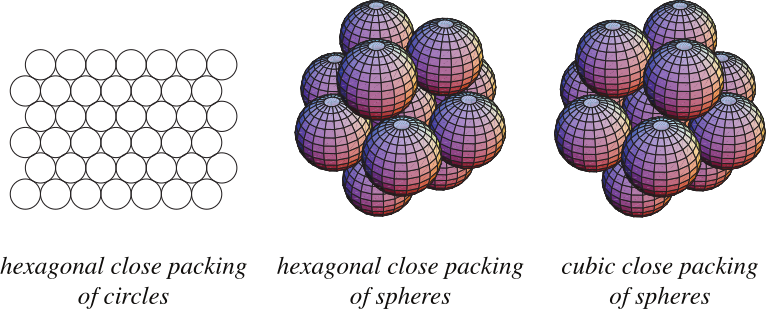In two dimensions, there are two periodic circle packings for identical circles: square lattice and hexagonal lattice. In 1940, Fejes Tóth proved that the hexagonal lattice is the densest of all possible plane packings (Conway and Sloane 1993, pp. 8-9).
The analog of face-centered cubic packing is the densest lattice packing in four and five dimensions. In eight dimensions, the densest lattice packing is made up
of two copies of face-centered cubic. In six and seven dimensions, the densest lattice
packings are cross sections of the eight-dimensional
case. In 24 dimensions, the densest packing appears to be the Leech
lattice. For high dimensions (-D), the densest known packings are nonlattice.
The densest lattice packings of hyperspheres in dimensions are known rigorously for
, 2, ..., 8, and have packing
densities
summarized in the following table, which also gives the corresponding Hermite
constants
(Gruber and Lekkerkerker 1987, p. 518; Hilbert and Cohn-Vossen 1999, p. 47;
Finch) and relevant literature citations.
| reference | |||
| 2 | Kepler 1611, 1619; Lagrange 1773 | ||
| 3 | 2 | Kepler 1611, 1619; Gauss 1840 | |
| 4 | 4 | Korkin and Zolotarev 1877 | |
| 5 | 8 | Korkin and Zolotarev 1877 | |
| 6 | Blichfeldt 1934, Barnes 1957, Vetčinkin 1980 | ||
| 7 | 64 | Blichfeldt 1934, Watson 1966, Vetčinkin 1980 | |
| 8 | 256 | Blichfeldt 1934, Watson 1966, Vetčinkin 1980 |
The packing densities of the densest known non-lattice packings of
hyperspheres in dimensions up to 10 are given by Conway and Sloane (1995). Prior
to 2016, no proofs that any packing in dimensions greater than 3 was optimal were
know (cf. Sloane 1998). However, in 2016, Maryna Viazovska announced a proof that
the
lattice provides the optimal packing in eight-dimensional space (Knudson 2016, Morgan
2016). Very shortly thereafter, Viazovska and collaborators announced a similar proof
that the Leech lattice is optimal in 24 dimensions
(Grossman 2016, Klarreich 2016).

The largest number of unit circles which can touch a given unit circle is six. For spheres,
the maximum number is 12. Newton considered this question long before a proof was
published in 1874. The maximum number of hyperspheres that can touch another in dimensions is the so-called kissing
number.
The following example illustrates the sometimes counterintuitive properties of hypersphere packings. Draw unit -spheres in an
-dimensional space centered at all
coordinates. Now place an additional hypersphere
at the origin tangent to the other hyperspheres.
For values of
between 2 and 8, the central hypersphere is contained
inside the hypercube with polytope
vertices at the centers of the other spheres. However, for
, the central hypersphere
just touches the hypercube of centers, and for
, the central hypersphere
is partially outside the hypercube.
This fact can be demonstrated by finding the distance from the origin to the center of one of the hyperspheres, which is given by
The radius of the central sphere is therefore . Now, the distance from the origin to the center of
a facet bounding the hypercube
is always 1 (one hypersphere radius), so the center hypersphere
is tangent to the hypercube when
, or
, and partially outside it for
.